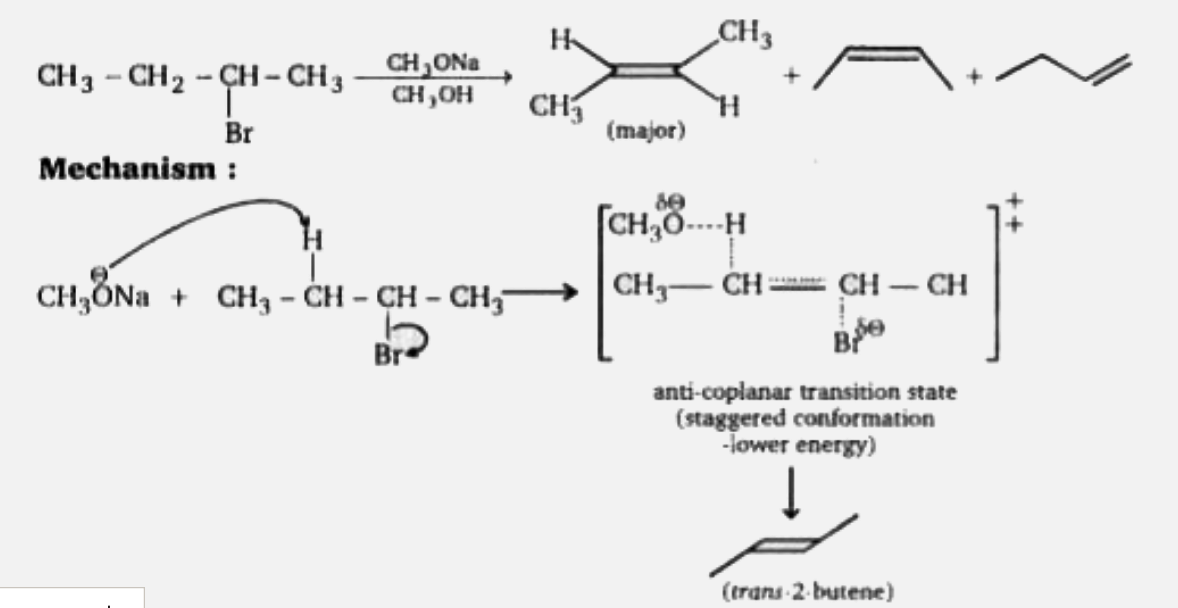 Hbr−−→(X)Nal−−−→acetone(Y)(Major), Product (Y) is :Solution in Kannada
Hbr−−→(X)Nal−−−→acetone(Y)(Major), Product (Y) is :Solution in Kannada
cis-2-butene
trans - 2- butene
1-butene
Iso-butene
The correct Answer is:B
Substitution followed by elimination (trans major)

Topper's Solved these Questions
- ALKYL HALIDES (ELIMINATION REACTION) BOOK - MS CHOUHANCHAPTER - ALKYL HALIDES (ELIMINATION REACTION) EXERCISE - LEVEL-2
25 Videos
- ALDEHYDES AND KETONESBOOK - MS CHOUHANCHAPTER - ALDEHYDES AND KETONESEXERCISE - LEVEL-2
20 Videos
- ALKYL HALIDES (SUBSTITUTION REACTIONS)BOOK - MS CHOUHANCHAPTER - ALKYL HALIDES (SUBSTITUTION REACTIONS)EXERCISE - LEVEL-2
41 Videos
Similar Questions
Comprehension
E2 raction → Elimination bimolecular
In the general mechanism of the E2 reaction a strong base abstract a proton on a carbon atom adjacent to the one of the leaving group. As the abstracts a proton , a double bond forms and the leaving group leaves.

Identify the rate of reaction of given compounds in E2 reaction:

View SolutionSelect the best choice for example (A to L) from the examples (a to n) given below. Write your choice in the box given.


View SolutionStatement - 1 : Nucleophilicity order in polar-protic solvent is I−<Br−<Cl−<F−
Statement-2 : Due to bigger size of I it is less solvated in polar-protic solvent.
View Solution , HBr(1equivalent)−−−−−−−−−−−→ Major product is :
, HBr(1equivalent)−−−−−−−−−−−→ Major product is :
View SolutionEthanol overset(P_(4)//I_(2))rarr X overset((i)KOH(alc))underset((ii) HBr)rarr Y In this sequence of reactions Y is :
View SolutionAcetone overset(NH_(2)OH)rarr X overset(LiAIH_(4))rarr Y . In the above sequence Y is
View SolutionGlucose overset(HCN)rarr (X) overset("hydrolysis")rarr (Y) underset(Delta)overset(HI)rarr (A) A is-
View SolutionO3−−−−−→Zn (A) KOH−−−−−→Δ
(B) Major product (B) is :

View SolutionIsobutylene underset("peroxides")overset(+HBr)rarr product is :
View SolutionWhat are Xand Y =in the following reaction sequence? " Propene " overset(HBr)rarr A overset(Mg)underset("Dry ether")rarr B overset(1.x)underset(2. H_3O^+)rarr
View SolutionIn the reaction, CH_3-CHunderset(Br)underset(|)(CH)-(CH_3)overset("Alc. KOH")(rarr)(A) underset("peroxide")overset(HBr)(rarr)(B)underset("Acetone")overset(NaI)(rarr)(C) . The compound (C ) is
View SolutionC_6H_6 underset(H_2SO_4)overset(HNO_3)(rarr)X underset(FeBr_3)overset(Br_2)rarr Y .The compound Y is
View SolutionF_3C-CH=CH_2 overset(HBr)(rarr) (A) overset(Nal) underset(dry acetone)(rarr) (B)
View SolutionComplete the following reaction : (i) Isopropyl bromide underset(KOH, Delta)overset("Alcohol")rarr X underset("Peroxide")overset("HBr")rarr Y (ii) n-propyl Alcohol underset(443K)overset("Conc."H_(2)SO_(4))rarr X underset(C)overset(HBr)rarrY (iii) 1-Chloropopane underset(KOH)overset("Ethanol")rarr (B) underset(C Cl_(4))overset(HBr)rarr Y (iv) Ethane underset(hv)overset(Cl_(2))rarr (B) overset("Na, Ether")rarr (C)
View SolutionIdentify (Z) in the series: CH_2=CH_2 overset(HBr)rarr(X)overset (Hydrolysis)rarr(Y) overset(NaOH)underset(I_2(excess))rarr(Z)
View SolutionCH_3CH_2COOH overset(Cl_2)underset(Fe)rarr X overset(alc)underset(KOH)rarr Y The compound Y Is :
View Solution
